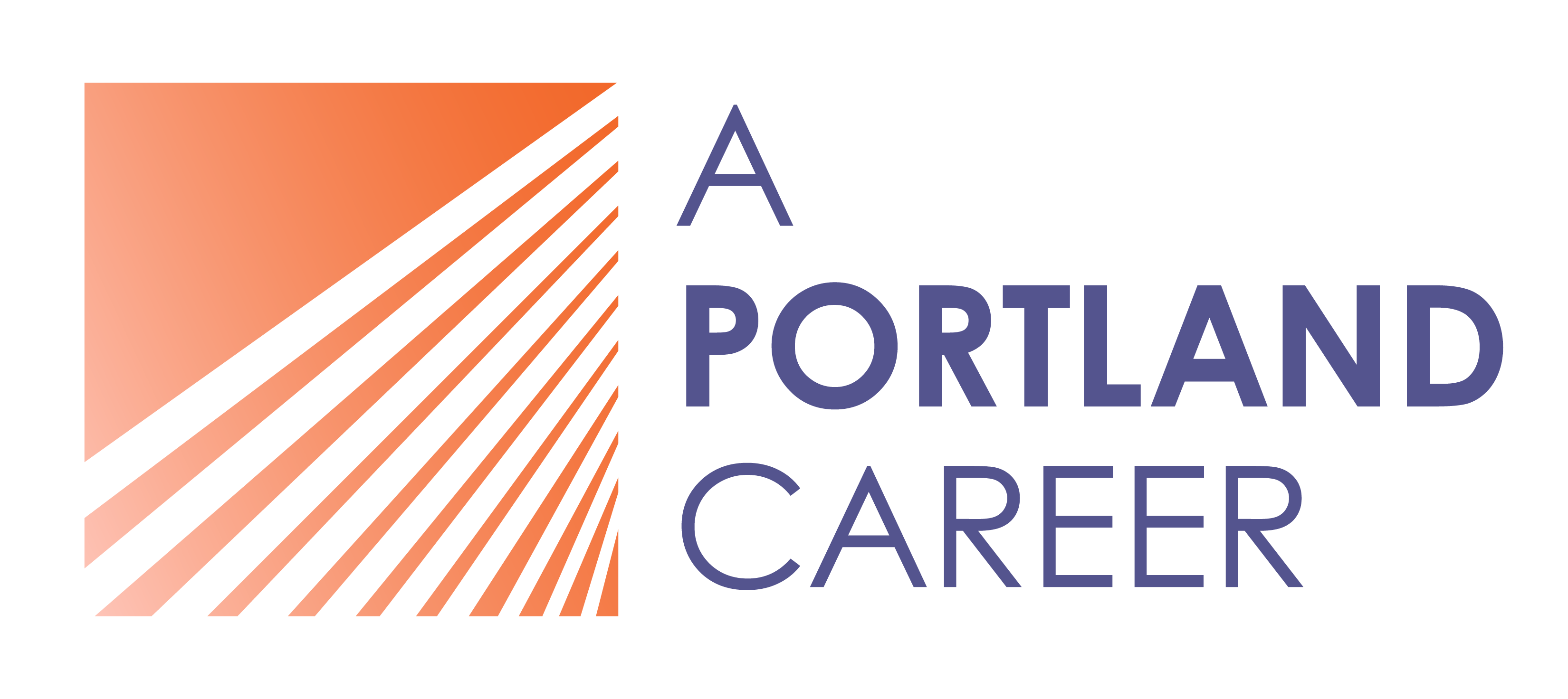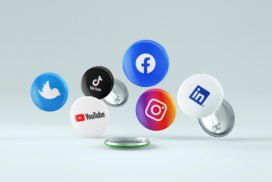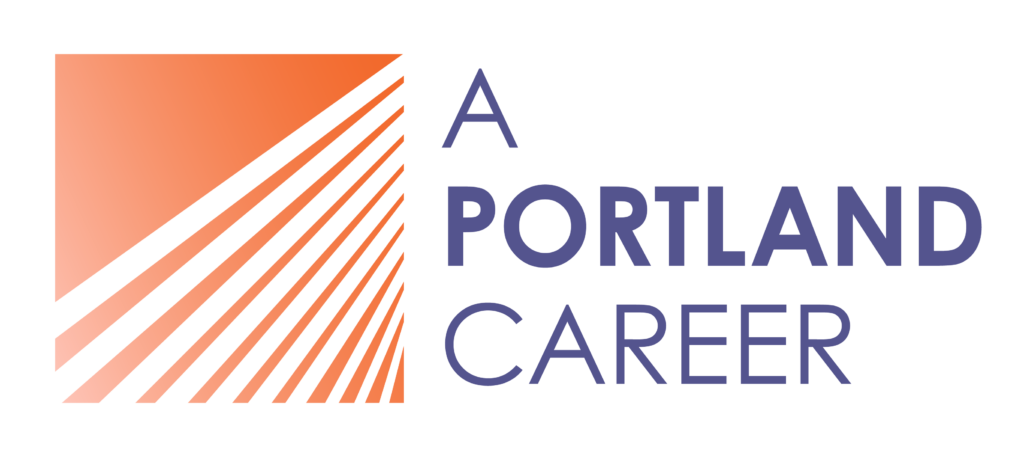How to avoid these 10 common job search mistakes and preserve your energy for the long haul of looking for a new role or career.
Optimize your LinkedIn profile to wage an effective job search—without your current boss finding out.
LinkedIn For Job Search: 10 Powerful Tips To Find Your Next Job*
(*Without Your Current Employer Knowing)
By Jelena Grove, and edited by Dan Hahn, M.S.
On the job hunt? Schedule a call and we’ll discuss your situation and how we can help
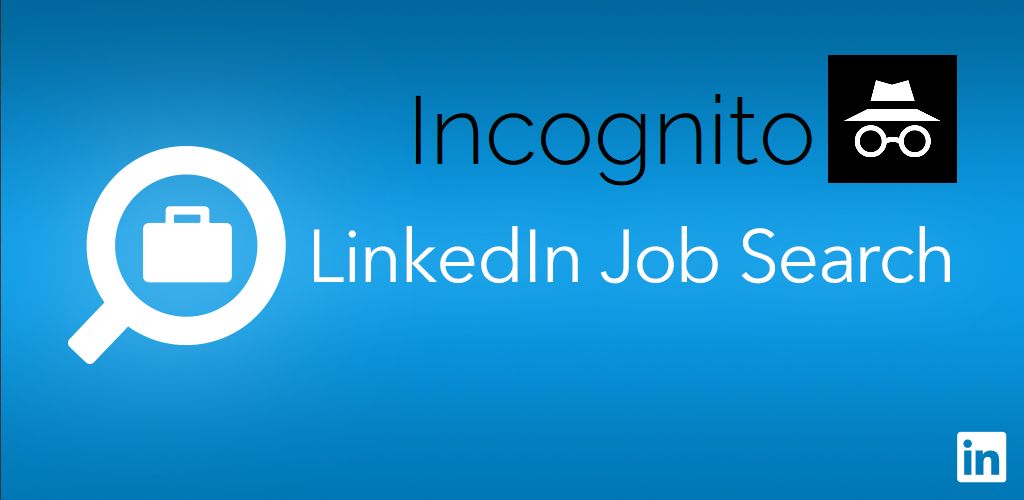
LinkedIn is more than just a social media platform. In the age of COVID-19 and an increasingly remote workforce, wise use of this popular online networking platform may just be the key to making your next career move—even if you’re doing it in private.
Ask anyone in the career counseling field for help with job research, and they’ll tell you to develop a solid networking strategy.
With over 15 million current job openings and 57 million listed companies, it’s no surprise why they’ll tell you to use LinkedIn for job search.
But, it’s extremely common to feel hesitant about using this social network. Privacy is a key issue for many LinkedIn users, especially if you’re new to the idea of using social media for job searching, or if you’re trying to find a job without your current employer knowing.
If you’re looking for tips on how to leverage LinkedIn’s immense trove of information, data, and connections to find job opportunities—and stay private in the process—you’ve found the right post.
Home → Helpful Articles → Job Search → LinkedIn For Job Search: 10 Powerful Tips To Find Your Next Job (Without Your Current Employer Knowing)
We’ve got a ton of articles about how to navigate your job search. Here are a few you might find helpful at this stage of your search:
- How To Recruit Recruiters with Your LinkedIn Profile
- The 6 Best Social Media Platforms for Job Seekers — and How To Use Them
- The Best-Kept Secrets for How to Find Your Next Job and Get Hired Using Twitter
- 6 Recruiter-Approved Tips to Maximize Facebook for Job Search
- The Best Job Boards in Portland OR and Beyond, and How to Use Them
- How To Find Remote Jobs: The Insider’s Guide to Your Next Remote Job Search
If you’re feeling stuck, reach out, and we’ll customize a job search to match where you’re at in the process.
On This Page
- How to Use Private Mode to Stay Anonymous on LinkedIn
- 10 Essential Ways to Use LinkedIn to Land Your Next Job
- Set up a profile (and actually use it)
- Make a winning first impression with a compelling headline
- Optimize your profile for keywords (and become searchable by recruiters)
- Research companies and industries with company pages
- Research jobs and career paths via individual pages
- Identify the best people for informational interviews
- Politely ask your connections for recommendations (and return the favor)
- Connect with alumni from your old schools
- Post content periodically and interact with other people’s content
- Be mindful of engagement timing: post in the morning, save DMs for after hours
- Final Thoughts

How To Use Private Mode To Stay Anonymous on LinkedIn
There’s nothing like the dreaded notification saying “you’re getting noticed!” or “someone viewed your profile” when you’re trying to be discreet about looking for a new job.
If you’re new to LinkedIn, or if you want to leave a current job and don’t want your employer to find out, it can feel a bit like everyone can see what you’re doing and whose profile you’re looking at.
Good news: LinkedIn has ultra-specific privacy settings that allow you to discretely browse people’s profiles, update your own profile, post content visible only by a specific audience, or add new people to your network (or remove them, discreetly). All you have to do is adjust a few privacy settings.
Adjusting your visibility settings
To make sure your LinkedIn page serves your job hunt without undermining your current working relationships, follow these simple steps:
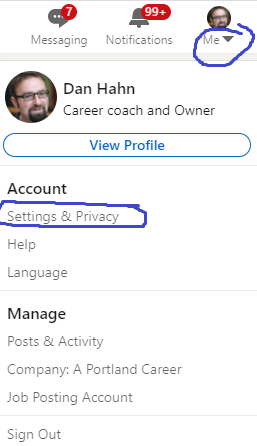
Step 1: At the top right of your screen under your profile photo, go to “Settings & Privacy”
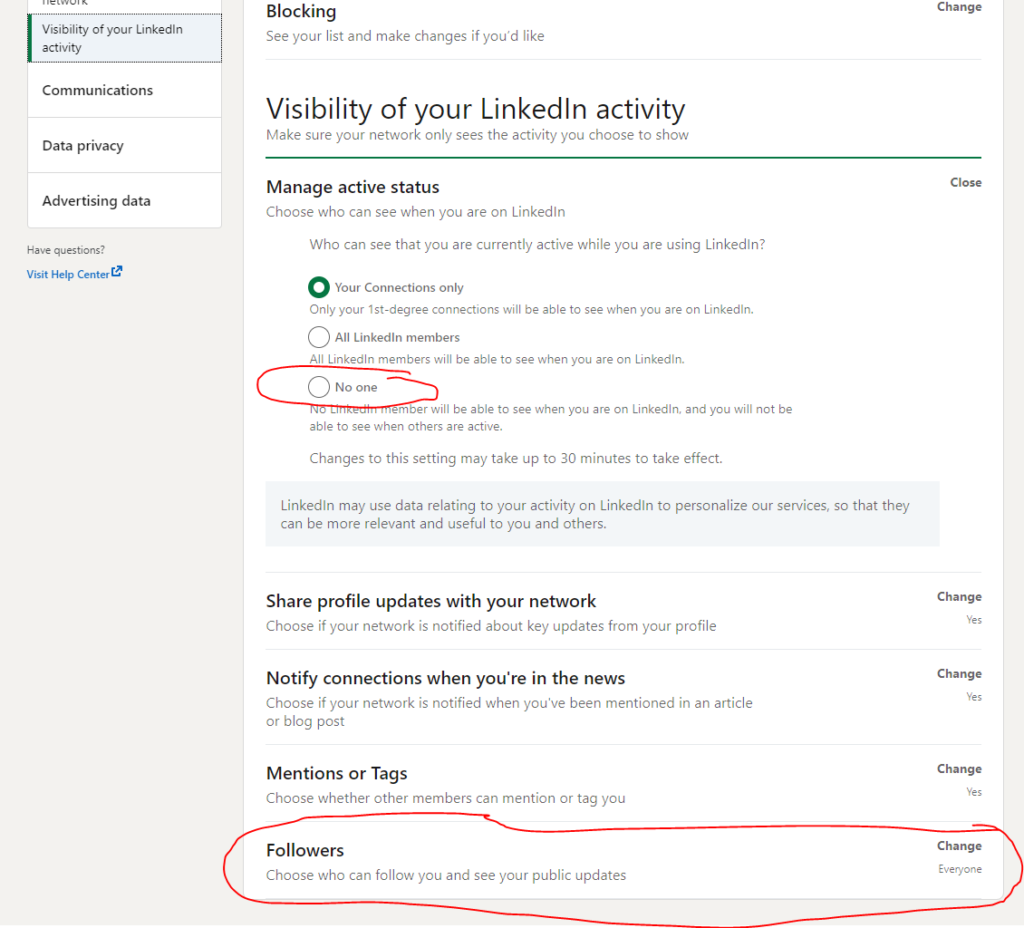
Step 2: In the table on the left under “Visibility,” you’ll see a whole panel of options for controlling your level of privacy in the app. You can adjust who can see your information (including your profile photo), posts, connections, and even the visibility of your last name.
To keep your job search activity on the down-low, consider modifying the highlighted areas in the image above. Whether you choose to stay public or go private, know that you have the option of changing these settings whenever you need to.
Why LinkedIn is a powerful job search tool
Work with Joanie
Press play!
In this video, Joanie Donnelly, our Resume and Cover Letter Expert, explains why LinkedIn is an essential tool for your job search.
Click the button to talk to Joanie about optimizing your LinkedIn profile, resumes, and cover letters.
10 Essential Ways To Use LinkedIn To Land Your Next Job
Now that you’ve adjusted your visibility settings and (hopefully) warmed up to the idea of using LinkedIn as a professional search engine, it’s time to learn 10 foundational ways to use this high-powered tool to research, prepare for, and land your next job.
#1: Set up a profile (and actually use it)
Make sure you’ve got all the basics of your online professional identity in place before you start researching: a decent, recent headshot as your profile picture, a bio with an overview of your skills, descriptions of past experience, education, and work history. You can also list awards and honors you’ve received to help you stand out from the rest.
But don’t think of your profile as a one-and-done thing. The more you update your profile by improving your page, engaging with others, and “connecting” with professionals in your target industry or job title, the more new opportunities you’re likely to find. And if you updated your visibility settings, nobody from your current job needs to find out.
Note: In our article, How to Network on LinkedIn Like a Pro, we show you how to create a great LinkedIn profile, build a rudimentary network, and then expand and tap into that network to help you find a job.
#2: Make a winning first impression with a compelling headline
Your LinkedIn headline is the first thing most people on the internet will read about you. It needs to be well thought out, use few words, position you as trustworthy, and contain strategically placed keywords that boost your profile’s visibility in recruiters’ and prospective employers’ LinkedIn searches.
Note: When you set up your profile, LinkedIn won’t allow you to leave the headline field blank. To hide your headline from public view as you experiment with different versions or wordings, go back to the Visibility tab (under Settings & Privacy) and select “Edit Your Public Profile.” On the right side you’ll see a control panel that allows you to customize the privacy level of your headline, as well as each section of your LinkedIn profile.
#3: Optimize your profile for keywords (and become searchable by recruiters)
If you want recruiters to be able to find you, you need to make your entire LinkedIn profile searchable –– not just your headline. To boost profile views where they count the most, you’ll need to sprinkle specific keywords that relate to your skills and desired job in other sections of your profile: about you, work experience, education, and activity (aka your posts).
What are the most important words that describe what you do, who you are, and the industry you want to work in? This step may take you looking at a few other people’s profiles in your industry to get a sense of how people are using keywords in the most effective way.
See how our client did it:
Jim, a training director, optimized his LinkedIn profile with keywords that matched up with commonly searched terms in his desired field. A recruiter from Providence found his profile and invited him in for an interview.
#4: Research companies and industries via Company Pages
Use this Advanced Search function to find information about companies and industries, identify people for potential introductions or interviews, or get alerts about job postings. All you need to do is search for a company name to reveal its posts, people on staff, job descriptions, and pertinent information (including whether or not they’re hiring for open jobs!).
You can narrow down your company search by searching for a keyword or set of keywords, then refining by desired location, industry, and company size.
See how our client did it:
#5: Research jobs and career paths via Individual Pages
You can learn a lot about the job market just by looking at other LinkedIn members’ profiles: how they got started in their careers, their current experience level, where they went to school, what their entry-level jobs were, how they’ve set up their profile. Plus, if their profile is well-developed, you can learn about the duties and responsibilities of more advanced jobs to determine if that type of job is a fit for you.
Suppose you’re looking for a job in the sports marketing industry. Go to the Home page and type “marketing AND sports” in the search field:
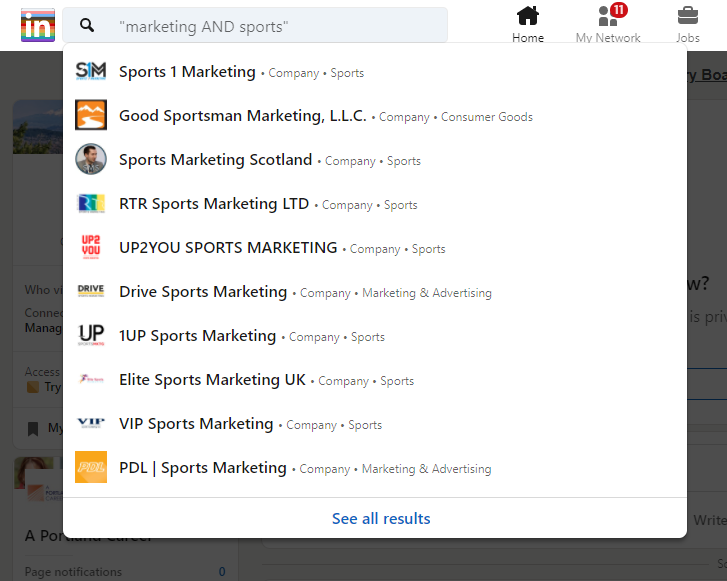
Then, click “See all results.” From there, click on “See all people results” to get a list of people who have the words “sports” and “marketing” anywhere in their profile:
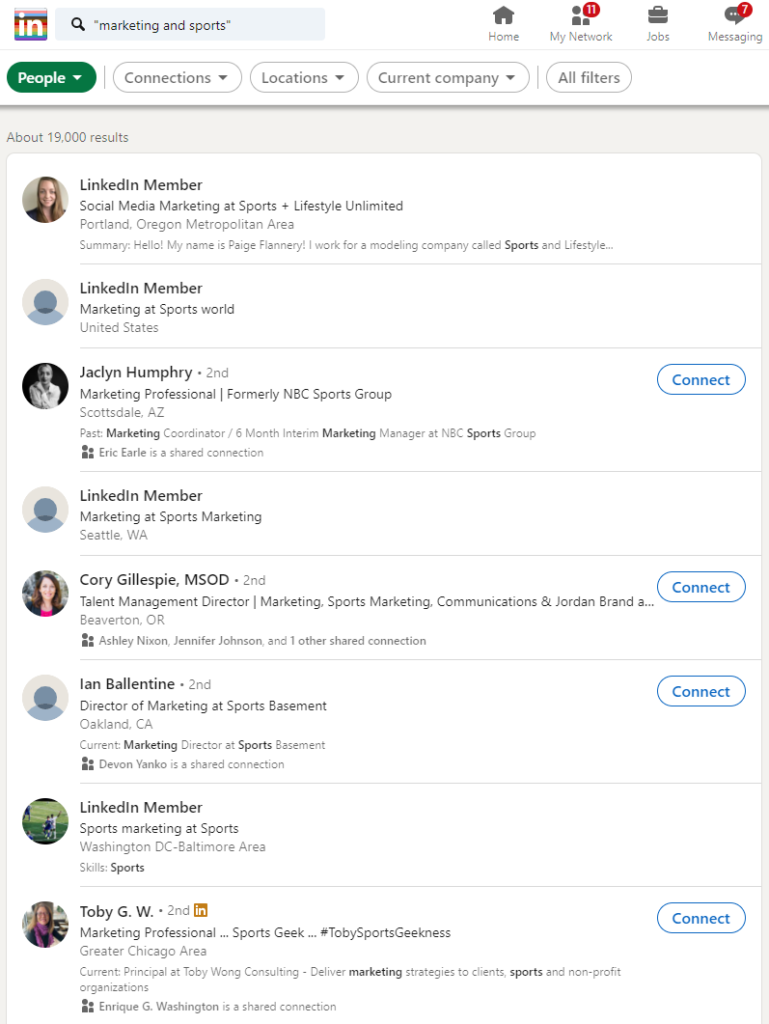
#6: Identify the best people for informational interviews
LinkedIn is full of career experts, recruiters, and industry leaders that could be great resources for informational interviews. But beyond that, it’s helpful to find people with your desired job title––even if they’re working outside of your target industry.
As you read through profiles, take note of the content they post, their headline and bio, and the way they describe their former jobs in their work history. If you can find people whose values and motivation you’re aligned with, chances are there’s potential for genuine connection there. While it may seem odd to message someone out of the blue to ask them about their job, you’d be surprised how many people would be thrilled at the chance to share insights and experiences with you.
Informational interviews are a great opportunity to get the inside scoop on questions like:
-
- What is the company culture like at company X?
- What can you tell me about DEI initiatives at company X?
- Most employees at company X are in their 30s. Do you think this is still a good company for me given that I am in my 50s?
- Can you tell me something about the hiring process at company X?
- Do you know anyone else with job title X in this or similar companies who would be willing to speak with me?
Note: In our article on informational interviews, we show you how to land quality introductions through shared interests and common connections (“2nd-degree connections” in LinkedIn lingo).
#7: Politely ask your connections for recommendations (and return the favor)
The LinkedIn recommendations section at the bottom of your profile page is one of the most important –– and most commonly neglected –– parts of the job search puzzle.
If the rest of your profile is selling your skills, this section is the proof point (or the evidence) for your professional character. No pressure. But don’t be shy! It’s common to reach out to other LinkedIn members (like past clients, colleagues, or supervisors) to endorse you for your skills. Just don’t forget to return the favor.
If you’re just starting out, you may not have had the chance to ask many other people to vouch for you publicly on the internet. That’s fine! Just keep connecting and doing great work, endorsing others, and the recommendations will follow.
See how our client did it:
#8: Connect with alumni from your old schools
You’re better connected than you think, thanks to LinkedIn’s handy “alumni” feature. If you follow the school page for your high school and/or university alma maters on LinkedIn, you’ll see there’s an “alumni” tab. When you click it, you’ll see a snapshot of where your fellow alumni are working, where they live, what they studied, and more.
With your school as your common denominator, you’ll discover a rich source of new leads, prospects, and potential connections.
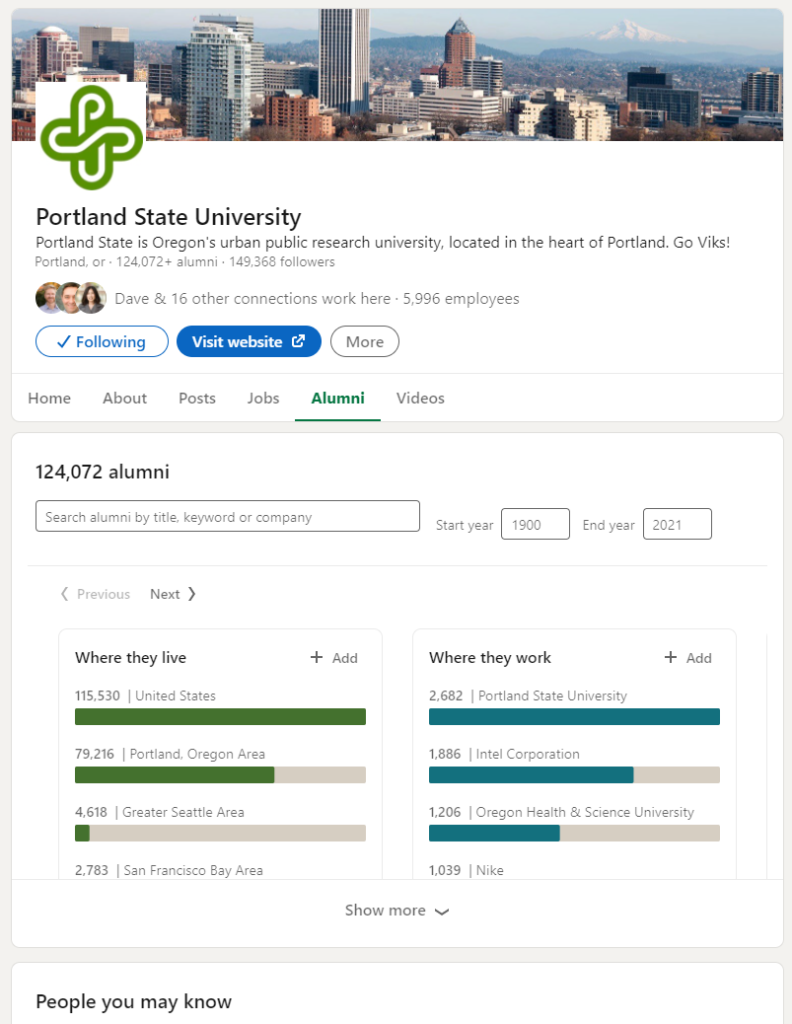
#9: Post content periodically (and interact with other people’s content)
Go ahead and be a wallflower as you get used to the platform. But beware of getting too used to only lurking on LinkedIn in private. Authentic engagement –– whether by posting original or recycled content and/or engaging with other peoples’ content –– is the best way to build recognition and credibility in the circles you’re aiming for.
Just remember: you don’t have to overthink it. You don’t have to post daily or spend an inordinate amount of time trying to appear a certain way or impress anyone. Just focus on putting out content that’s relevant, engaging, and professional, in whatever way is most consistent and sustainable for you.
#10: Be mindful of engagement timing: post In the morning, save DMs for after hours
People tend to be most active on LinkedIn messenger after normal work hours. They may be scrolling and liking content during the day, but they’ll be more likely to respond to direct messages when they’re done with their daily tasks.
You don’t need to spend too much time on engagement. Whether you just use the mobile app or your desktop — all it takes is the right message or the right post at the right time. You may only want to spend 10-25 minutes reading and responding to messages only a few days a week. That’s fine! As long as you’re staying thoughtful, consistent, and not leaving any leads hanging in your inbox.
See how our clients did it:
Bev, a project manager in waste reduction, sent direct messages to 15 different colleagues in her network. One of them sent her a position announcement that was a perfect match.
Drew’s goal was a position with the State of Oregon. When he wasn’t able to meet hiring managers in the tightly regimented hiring environment, his LinkedIn contacts helped him understand the state’s complex application process, gave him tips on how to score maximum points on his applications and tests, and even helped him polish up his resumes.

Final thoughts on using LinkedIn for job search
To date, none of our clients has had a bad experience on LinkedIn. Through this process, you’ll be shocked to discover just how many caring, generous, empowering people there are out there –– eager to share their wisdom and experience with job seekers like you.
Just remember, it can take a while to get the hang of it. Give the platform some time. Be patient. Double-check your privacy settings. Before you know it, you’ll be ready to buckle down and start networking your way to your next job with confidence.
Now that you’re armed with the knowledge of how to browse like a pro in private mode, we hope you’ll at least give this powerful career tool a shot.
For more on how to make an outstanding LinkedIn profile, visit our guide here.
Key takeaways
- Adjust your visibility settings to ensure complete anonymity as you browse profiles, expand your network, and engage with content across LinkedIn’s vast trove of professional resources.
- Create a standout professional profile and keep it active in target circles to increase your chances of landing a job interview
- Use keywords to conduct super-specific job searches and get your profile seen by recruiters
- Research jobs, industries, and career paths on LinkedIn company pages and individual profiles
- Don’t be shy about sending private messages and asking other LinkedIn professionals for guidance, advice, or information
Related articles you might be interested in:
How To Recruit Recruiters with Your LinkedIn Profile
Jumpstart your networking efforts with these 11 expert tips to create a LinkedIn profile that really stands out.
The 6 Best Social Media Platforms for Job Seekers — and How To Use Them
Learn about the best social media platforms for job seekers and how to use them to network, explore careers and industries, and find jobs.
How to Find Remote Jobs: The Insider’s Guide to Your Next Remote Job Search
Is remote work right for you? We reveal the best remote job boards and share insider tips for how to find remote jobs.
